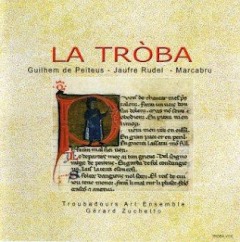La Tròba - Anthologie chanté des Troubadours XIIe et XIIIe siècles Vol.1 (1985)
La Tròba - Anthologie chanté des Troubadours XIIe et XIIIe siècles Vol.1 (1985)

Guilhem de Peiteus
1. Companho farai un vers pauc convinen
2. Pos de chantar m'es pres talens
Jaufre Rudel
3. Lanquan il jorn son lonc en mai
4. No sap chantar qui so no di
5. Quan lo rius de la fontana
6. Quan lo rossinhols e.l folhos
Marcabru
7. Bei m'es quan son li frug madur
8. Dirai vos senes doptansa
9. L'autre ier a l'eissida d'abriu
10. L'autr'ier jost'una sebissa
11. Lo vers comensa
12. Lo vers comens quan vei del fau
13. Pax in nomine Domini
Troubadours Art Ensemble:
Voices:
Sandra Hurtado-Ròs, Isabelle Bonnadier, Equidad Barès, Martina "Joia" de Peira,
Maurice Moncozet, Gérard Zuchetto;
Instruments:
Guy Robert (ud', medieval lute, harp),
André Rochard (ud', medieval lute, gittern, cittern, vielles, rebec, shawms),
Véronique Condesse (harp),
Valérie Loomer (gittern, cittern),
Patrice Villaumé (dulcimer, hurdy-gurdy),
Nick Blanton (dulcimer), Patrice Brient (dulcimer),
Regef (vielles, rebec, hurdy-gurdy),
Domitille Vigneron (vielles, rebec),
Maurice Moncozet (vielles, rebec),
Denyse Dowling (recorders, shawms),
Christophe Deslignes (organetto),
Thierry Gomar (percussions), Jacques Khoudir (percussions).
A troubadour was a composer and performer of Old Occitan lyric poetry during the High Middle Ages (1100–1350). Since the word "troubadour" is etymologically masculine, a female troubadour is usually called a trobairitz.
The troubadour school or tradition began in the 11th century in Occitania, but it subsequently spread into Italy, Spain, and even Greece. Under the influence of the troubadours, related movements sprang up throughout Europe: the Minnesang in Germany, trovadorismo in Galicia and Portugal, and that of the trouvères in northern France. Dante Alighieri in his De vulgari eloquentia defined the troubadour lyric as fictio rethorica musicaque poita: rhetorical, musical, and poetical fiction. After the "classical" period around the turn of the 13th century and a mid-century resurgence, the art of the troubadours declined in the 14th century and eventually died out around the time of the Black Death (1348).
The texts of troubadour songs deal mainly with themes of chivalry and courtly love. Most were metaphysical, intellectual, and formulaic. Many were humorous or vulgar satires. Works can be grouped into three styles: the trobar leu (light), trobar ric (rich), and trobar clus (closed). Likewise there were many genres, the most popular being the canso, but sirventes and tensos were especially popular in the post-classical period, in Italy and among the female troubadours, the trobairitz.
download: uploaded yandex 4shared mediafire solidfiles mega filecloudio nornar
Last Updated (Tuesday, 18 February 2014 12:13)








